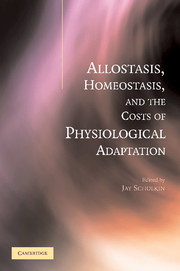Book contents
- Frontmatter
- Dedication
- Contents
- Preface
- Contributors
- Introduction
- 1 Principles of Allostasis: Optimal Design, Predictive Regulation, Pathophysiology, and Rational Therapeutics
- 2 Protective and Damaging Effects of the Mediators of Stress and Adaptation: Allostasis and Allostatic Load
- 3 Merging of the Homeostat Theory with the Concept of Allostatic Load
- 4 Operationalizing Allostatic Load
- 5 Drug Addiction and Allostasis
- 6 Adaptive Fear, Allostasis, and the Pathology of Anxiety and Depression
- 7 A Chronobiological Perspective on Allostasis and Its Application to Shift Work
- 8 Allostatic Load and Life Cycles: Implications for Neuroendocrine Control Mechanisms
- Commentary: Viability as Opposed to Stability: An Evolutionary Perspective on Physiological Regulation
- Index
6 - Adaptive Fear, Allostasis, and the Pathology of Anxiety and Depression
Published online by Cambridge University Press: 05 February 2015
- Frontmatter
- Dedication
- Contents
- Preface
- Contributors
- Introduction
- 1 Principles of Allostasis: Optimal Design, Predictive Regulation, Pathophysiology, and Rational Therapeutics
- 2 Protective and Damaging Effects of the Mediators of Stress and Adaptation: Allostasis and Allostatic Load
- 3 Merging of the Homeostat Theory with the Concept of Allostatic Load
- 4 Operationalizing Allostatic Load
- 5 Drug Addiction and Allostasis
- 6 Adaptive Fear, Allostasis, and the Pathology of Anxiety and Depression
- 7 A Chronobiological Perspective on Allostasis and Its Application to Shift Work
- 8 Allostatic Load and Life Cycles: Implications for Neuroendocrine Control Mechanisms
- Commentary: Viability as Opposed to Stability: An Evolutionary Perspective on Physiological Regulation
- Index
Summary
The traumatic events of September 11, 2001, have dramatically changed our lives forever. Americans and people around the world were shocked by the unprecedented and horrific attacks on civilians. The anthrax scare further shook the security and complacency of Americans. We must all live with heightened vigilance and increased fear of more unpredictable attacks.
With the attacks and their aftermath, many Americans experienced levels of emotion, particularly fear and anxiety, to which they are unaccustomed. Many experienced acute posttraumatic symptoms (Schuster et al., 2001; Galea et al., 2002; Schlenger et al., 2002; Silver, et al., 2002). Although some people do not recover well from the trauma and develop chronic anxious or depressive conditions, in the vast majority of cases, these feelings recede, and people go on with their normal lives. These people will not return to their previous state, however – the external world has changed, and their internal psychological states have changed, too.
What are the psychological and biological mechanisms for the rapid change in emotion, and then the return to a normal although changed life, or, in some cases, to a new life of pathological states of anxiety or depression?
This chapter explores the processes by which mammals maintain viability following physiological change due to adversity. These processes are captured by the concept of allostasis – a means of achieving psychological and biological states appropriate to changed circumstances. We address this concept within the context of the neurobiology of the normal, adaptive emotion of fear and pathological states of anxiety and depression, which can result from sustained or overexpressed normal feed-forward mechanisms associated with fear. We begin with definitions of allostasis, adaptive fear, and pathological anxiety. Several learning and conditioning mechanisms that are involved in adaptive fear are discussed next. The brain systems and circuits involved in fear, particularly those of the amygdala and associated structures, are described in a context of adaptive processes.
- Type
- Chapter
- Information
- Publisher: Cambridge University PressPrint publication year: 2004
- 9
- Cited by



